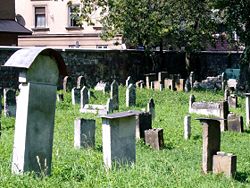Remah Cemetery



The Remuh Cemetery, also known as the Old Jewish Cemetery of Kraków,[1] located in Kraków, Poland, is an inactive Jewish historic cemetery established in 1535.[2] It is located in the Renaissance Kazimierz district of the city beside the 16th-century Remuh Synagogue, at 40 Szeroka Street. In 1800, the cemetery was closed and the nearby New Jewish Cemetery was built at 55 Miodowa Street. Izaak Jakubowicz, donor of the Izaak Synagogue is buried there.[3]
During the German occupation of Poland, the Nazis destroyed the cemetery tearing down the walls and hauling away tombstones to be used as paving stones in the camps, or selling them for profit. The tombstone of the Remah (Rabbi Moses Isserles) is one of the few that remained intact. The cemetery has undergone a series of post-war restorations. As is common in contemporary Poland, all tombstones unearthed as paving stones have been returned and re-erected, although they represent a small fraction of the monuments that once stood in the cemetery.[2]
The cemetery holds the gravesites of many notable Polish Jews,[2] including:
- Rabbi Moses Isserles (ca. 1525-1572), buried there along with his family;
- Mordechaj Saba (called Singer), head of the Kraków Talmudic Academy from 1572 to 1576;
- Joseph Kac, head of the Academy from 1576 to 1591.
- Nathan Nata Spira (1583-1633),[1] Kraków rabbi and head of the Academy from 1617 to 1633;
- Jozue ben Joseph (1590-1648), also head of the Academy;
- Joel Sirkes Bach, (1561-1640), rabbi of the Kraków Jewish community and head of the Academy;
- Isaac Landau Lewita, rabbi of Kraków's Jewish community from 1754 to 1768;
- Isaac Halewi, Kraków's rabbi and head of the Academy from 1776 to 1799.[3]
- Rabbi Yom-Tov Lipmann Heller, (1578-1654), a Bohemian rabbi and Talmudist, best known for writing a commentary on the Mishnah called the Tosafot Yom-Tov.
- Yossele the Holy Miser, central figure in a well-known tale of Jewish folklore.
- Avraham Yehoshua Heschel, Chief Rabbi of Kraków.[1]
See also
![]() Media related to Remuh Cemetery in Kraków at Wikimedia Commons
Media related to Remuh Cemetery in Kraków at Wikimedia Commons
Notes and references
- ^ a b c Sherwin, Byron L. (1997). Sparks Amidst the Ashes: The Spiritual Legacy of Polish Jewry. Oxford University Press US. ISBN 978-0-19-510685-5.
- ^ a b c HFG (2007). "The Remuh Synagogue of Krakow, Poland". The Database of Jewish Communities. Museum of the Jewish People Online. Archived from the original (Internet Archive) on October 11, 2008. Retrieved July 31, 2013.
{{cite web}}: Unknown parameter|deadurl=ignored (|url-status=suggested) (help) - ^ a b WCSS (2004), The Old Cemetery (Internet Archive) Cemeteries in Cracow [Kraków]. Retrieved July 31, 2013.
